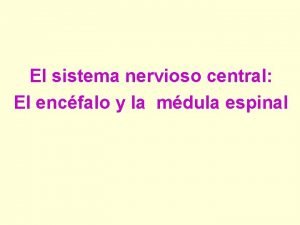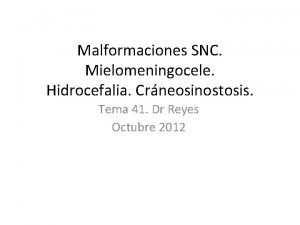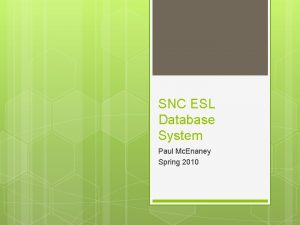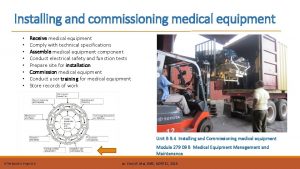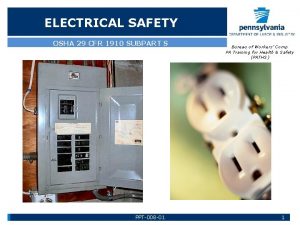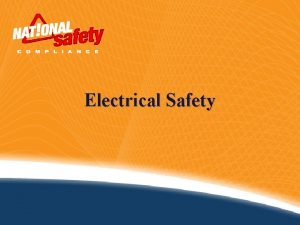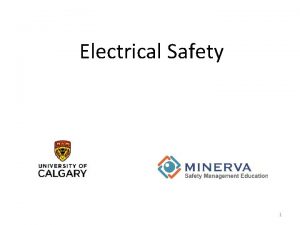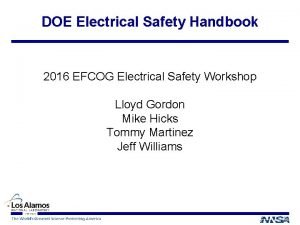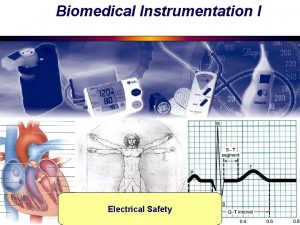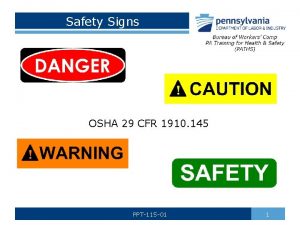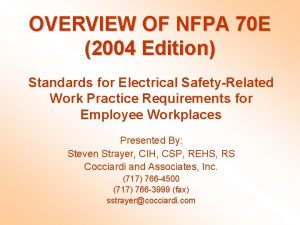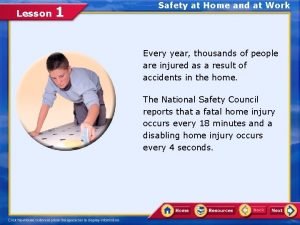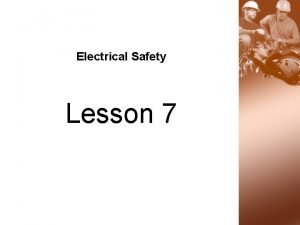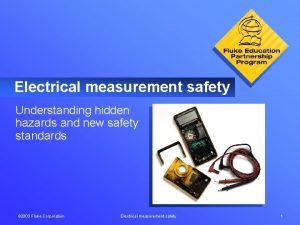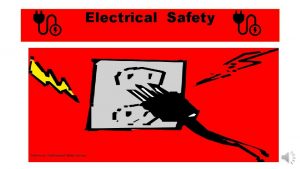SNC 1 P PHYSICS ELECTRICAL APPLICATIONS Electrical Safety
























- Slides: 24

SNC 1 P PHYSICS ELECTRICAL APPLICATIONS � Electrical Safety (P. 522 -524)

Electric Shocks & Fires You can be severely injured or even killed by electric shocks. Your body uses electrical signals to communicate with your muscles, including your heart. A current passing through your body would interfere with these signals. Your muscles would contract and jerk violently. Your body tissues could even burn. January 20, 2022 1 PPHYS - Electrical Safety 1

Electric Shocks & Fires Electric shocks can be caused by poorly insulated wires. An electric shock could also occur if you wet your skin with tap water – since electrons can now flow over a larger area, more current can flow through your body. Once past the skin, current flows easily because we are filled with chemicals that conduct electricity. January 20, 2022 1 PPHYS - Electrical Safety 2

Electric Shocks & Fires One of the most common dangers with circuits in homes involves overloading a circuit. A circuit can become overloaded when you plug too many loads into the same circuit. To prevent overheating and fires, safety devices such as fuses and circuit breakers are installed. January 20, 2022 1 PPHYS - Electrical Safety 3

Electrical Safety Devices A fuse contains a thin piece of metal that is designed to melt when too much current passes through it. Once the metal melts, the circuit is broken and the current stops. A blown fuse must be replaced as it can only work once. Fuses come in various sizes and shapes depending upon the application. January 20, 2022 1 PPHYS - Electrical Safety 4

Electrical Safety Devices A circuit breaker does the same job as a fuse except the wire does not melt. Instead, when too much current passes through them the wire heats up and bends, which triggers or “trips” a spring mechanism that turns off the flow of electricity. Once the breaker has cooled, it can be reset. January 20, 2022 1 PPHYS - Electrical Safety 5

Electrical Safety Devices Another safety feature is the shape, size, and position of the prongs on plugs. Most plugs only fit one way in an outlet because one prong is wider. The third prong on a three-prong electrical plug connects the device to the ground wire of the building sending any unwanted current flow directly to the ground. The plug on an oven is designed to be plugged in only one way. Electrical outlet covers are another safety feature. January 20, 2022 1 PPHYS - Electrical Safety 6

Electrical Safety Devices Some appliances and devices have an added safety feature. A ground fault circuit interrupter (GFCI) is a device that detects a change in current and opens the circuit, stopping current flow. For example, if an appliance gets wet while you are handling it and some current starts to flow through the water, the GFCI opens the circuit so there is less chance of injury to you. January 20, 2022 1 PPHYS - Electrical Safety 7

Electrical Safety Devices ELECTRICAL SAFETY v various devices are used to protect us • fuses (thin piece of metal melts) • circuit breaker (metal bends and trips the switch) • shape, size and position of prongs • outlet cover • ground fault circuit interrupter (GFCI) NOTE! Fuses are connected in series with a load. The symbol is January 20, 2022 1 PPHYS - Electrical Safety 8

Electrical Safety PRACTICE 1. (a) What is dangerous in the situation shown? (a) the woman is working with a drill that has a frayed cord near water January 20, 2022 1 PPHYS - Electrical Safety 9

Electrical Safety PRACTICE 1. (b) What should the worker do to be safer? (b) unplug the drill and fix the cord turn off the water January 20, 2022 1 PPHYS - Electrical Safety 10

Electrical Safety PRACTICE 1. (c) The drill is plugged into the wall with a three-prong plug. How does the third prong on the plug act as a safety mechanism? (c) the third prong connects the device to the ground wire of the building sending any unwanted current flow directly to ground January 20, 2022 1 PPHYS - Electrical Safety 11

Electrical Safety PRACTICE 2. Explain the reason for each safety rule. (a) Do not poke a knife into an electrical device such as a plugged-in toaster in order to clean out the bread crumbs. (a) you can shock yourself January 20, 2022 1 PPHYS - Electrical Safety 12

Electrical Safety PRACTICE 2. Explain the reason for each safety rule. (b) Do not plug many electrical devices into one outlet. (b) it can cause a fire January 20, 2022 1 PPHYS - Electrical Safety 13

Electrical Safety PRACTICE 2. Explain the reason for each safety rule. (c) Never use a frayed electrical cord. (c) you can shock yourself January 20, 2022 1 PPHYS - Electrical Safety 14

Electrical Safety PRACTICE 3. Explain why a fuse or circuit breaker must be connected in series with the rest of the circuit to be effective. so if the fuse or circuit breaker overheats and melts/trips then the current flow will be stopped January 20, 2022 1 PPHYS - Electrical Safety 15

Electrical Safety PRACTICE 4. What could happen if a blown fuse were replaced with one that blew at a much higher current than the original? it could hurt someone or start a fire January 20, 2022 1 PPHYS - Electrical Safety 16

Short Circuits Sometimes a wire’s insulation breaks down or another problem develops that allows electrons to flow through a device along a different path than the one intended. The device develops a short circuit. A short circuit is an accidental low-resistance connection between two points in a circuit. , often causing excess current flow. January 20, 2022 1 PPHYS - Electrical Safety 17

Short Circuits NOTE! Not only do short circuits mean that your device will not work, they can also be dangerous. The conducting wires and source can quickly become hot and possibly start a fire. January 20, 2022 1 PPHYS - Electrical Safety 18

Short Circuits SHORT CIRCUIT v accidental low-resistance connection between two points in a circuit v no load in the circuit to use up the energy as the current flows v the circuit and source may become hot enough to start a fire January 20, 2022 1 PPHYS - Electrical Safety 19

Short Circuits NOTE! One danger from short circuits occurs when a transmission line has been knocked down in a storm. Without a complete path, the electricity cannot flow. However, if you come in contact with the wire, electricity will take a path through your body to the ground and seriously injure or kill you. The driver in the truck is safe as long as they stay inside the truck. January 20, 2022 1 PPHYS - Electrical Safety 20

�Check Your Learning 1. What if the driver in the truck had to leave – what would he do? they would need to jump free – if they stepped out they would provide a path for the electricity to flow to the ground January 20, 2022 1 PPHYS - Electrical Safety 21

�Check Your Learning 2. One of the warnings printed on battery blister packs states “Do not carry batteries loose in your pockets or purse. ” Explain why. loose coins in a pocket or purse could make a short circuit – battery could heat up and start a fire and/or explode January 20, 2022 1 PPHYS - Electrical Safety 22

�Check Your Learning TEXTBOOK P. 524 Q. 1 -3 January 20, 2022 1 PPHYS - Electrical Safety 23
 Household safety symbols
Household safety symbols Sistema nervioso central
Sistema nervioso central Snc1d chemistry
Snc1d chemistry Snc lajaa venissieux
Snc lajaa venissieux Snc
Snc Snc
Snc Paul mcenaney
Paul mcenaney Principles and applications of electrical engineering
Principles and applications of electrical engineering Principles and applications of electrical engineering
Principles and applications of electrical engineering Modern physics vs classical physics
Modern physics vs classical physics University physics with modern physics fifteenth edition
University physics with modern physics fifteenth edition Ib physics ia ideas mechanics
Ib physics ia ideas mechanics Electrical safety analyzer
Electrical safety analyzer Osha subpart s
Osha subpart s Electrical safety introduction
Electrical safety introduction Electrical safety introduction
Electrical safety introduction Doe electrical safety handbook
Doe electrical safety handbook Microshock and macroshock
Microshock and macroshock What three elements are required for all electric circuits
What three elements are required for all electric circuits Electrical safety case study
Electrical safety case study 29cfr1910 120
29cfr1910 120 Nfpa 70e 2004 standard for electrical safety
Nfpa 70e 2004 standard for electrical safety Lesson 1: electrical safety culture
Lesson 1: electrical safety culture Lesson 7 electrical safety
Lesson 7 electrical safety Electrical measurement safety
Electrical measurement safety

